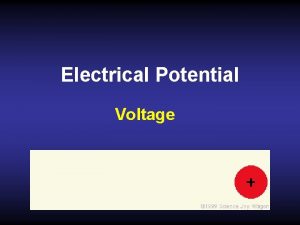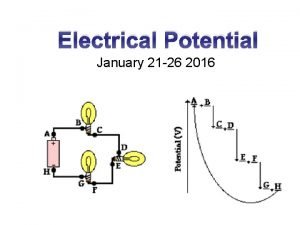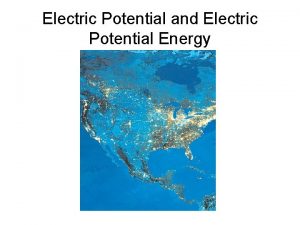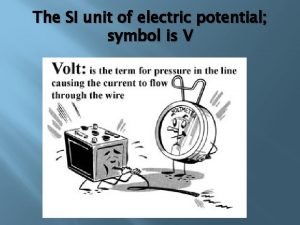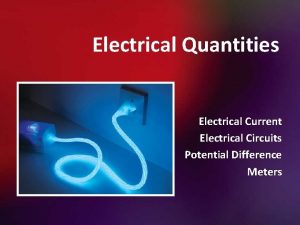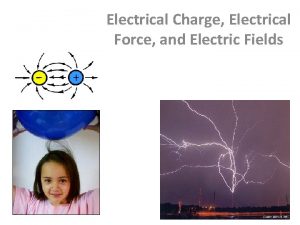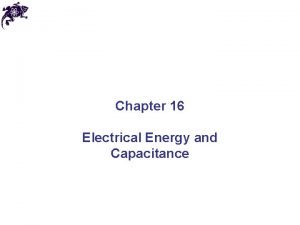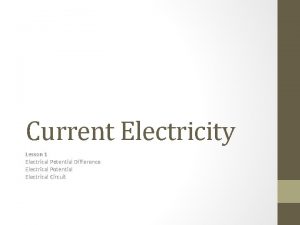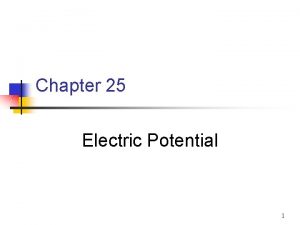Electrical Potential January 21 26 2016 Electrical Potential






























- Slides: 30

Electrical Potential January 21 -26 2016

Electrical Potential Energy Just as masses can have gravitational potential energy, charges can have electrical potential energy Electrical potential energy A mass gains PEg if work is done against gravity (i. e. , if the mass is moved against the gravitational field) E A charge gains PEe if work is done against electric force (e. g. , if the positive charge is moved against the electric field)

Electrical Potential Energy How can a charge (or mass) gain potential energy? By changing location. Gravitational potential energy Work done by monkey Work done by electricity Low PE High PE Electrical potential energy

Electrical Potential Energy & Charge Does the amount of work done by the monkey change if the charge changes? How do we know? What does this imply about potential energy? Potential energy depends on both location and charge.

Electrical Potential Energy & Electrical Potential Two different things that sound alike! Introducing … Electrical Potential (V) … a measure that depends only on location, not on charge. The SI unit of electric potential is the volt.

Electrical Potential Energy vs Electrical Potential A Two positive charges, A and B, are placed at equal distances from a positively charged sphere. +++++ + + ++++ + A has a larger charge than B. 0. 5 m ++ + +++ B 0. 5 m ++ + ++

Electrical Potential Energy vs Electrical Potential A Two positive charges, A and B, are placed at equal distances from a positively charged sphere. +++++ + + ++++ + A has a larger charge than B. 0. 5 m ++ + +++ B 0. 5 m ++ + ++ Which has greater potential energy (PE)? 1) A 2) B 3) They have the same PE Which has greater electrical potential (V)? 1) A 2) B 3) They have the same V

Electrical Potential Energy vs Electrical Potential A Two positive charges, A and B, are placed at equal distances from a positively charged sphere. +++++ + + ++++ + A has a larger charge than B. 0. 5 m ++ + +++ B 0. 5 m ++ + ++ Which has greater potential energy (PE)? 1) A 2) B 3) They have the same PE Which has greater electrical potential (V)? 1) A 2) B 3) They have the same V

Electrical Potential Energy vs Electrical Potential Note important difference between energy and potential: • A point has potential, charge placed there has electric potential energy A +++++ + + ++++ + 0. 5 m ++ + +++ B 0. 5 m ++ + ++ Two points that are at the same distance from the charged object have the same potential. So, when two charged objects are placed there, they are at the same potential, but the one with more charge on it has higher electric potential energy. It is harder to push it there.

Electrical Potential Energy vs Electrical Potential The quantity electric potential is defined as the amount of _____. 1. electric potential energy 2. force acting upon a charge 3. potential energy per charge 4. force per charge

Electrical Potential Energy vs Electrical Potential The quantity electric potential is defined as the amount of _____. 1. electric potential energy 2. force acting upon a charge 3. potential energy per charge 4. force per charge

Electrical Potential Energy vs Electrical Potential What happens if a positive charge is moved from point A to point B? Work done by external force?

Electrical Potential Energy vs Electrical Potential What happens if a positive charge is moved from point A to point B?

Potential Difference (ΔV) Charge will naturally move from areas of high potential to areas of low potential. Work / an input of energy is needed to move charge up from low potential to high

Potential Difference (ΔV) & Circuits What is the role of a battery in a circuit? Batteries supply energy to maintain a potential difference across the circuit.

Potential Difference (ΔV) & Circuits What is the role of a battery in a circuit? Batteries supply energy to maintain a potential difference across the circuit. 1) A 12 V battery means that the + terminal has an electric potential that is 12 V higher than the – terminal.

Potential Difference (ΔV) & Circuits What is the role of a battery in a circuit? Batteries supply energy to maintain a potential difference across the circuit. 1) A 12 V battery means that the + terminal has an electric potential that is 12 V higher than the – terminal. 2) Charges flow through the external circuit (the wire) from high to low potential.

Potential Difference (ΔV) & Circuits What is the role of a battery in a circuit? Batteries supply energy to maintain a potential difference across the circuit. 1) A 12 V battery means that the + terminal has an electric potential that is 12 V higher than the – terminal. 2) Charges flow through the external circuit (the wire) from high to low potential. 3) As the charges flow through the circuit, they ‘lose’ energy to circuit elements such as lights and motors

Potential Difference (ΔV) & Circuits What is the role of a battery in a circuit? Batteries supply energy to maintain a potential difference across the circuit. 1) A 12 V battery means that the + terminal has an electric potential that is 12 V higher than the – terminal. 2) Charges flow through the external circuit (the wire) from high to low potential. 3) As the charges flow through the circuit, they ‘lose’ energy to circuit elements such as lights and motors 4) By the time the charges get to the end terminal, they have used up 12 V of potential

Potential Difference (ΔV) & Circuits What is the role of a battery in a circuit? Batteries supply energy to maintain a potential difference across the circuit. 1) A 12 V battery means that the + terminal has an electric potential that is 12 V higher than the – terminal. 2) Charges flow through the external circuit (the wire) from high to low potential. 3) As the charges flow through the circuit, they ‘lose’ energy to circuit elements such as lights and motors 4) By the time the charges get to the end terminal, they have used up 12 V of potential 5) The battery supplies the energy necessary to ‘push’ the charges back to high potential

Potential Difference (ΔV) & Circuits As charges ‘lose’ energy to different circuit elements, the electric potential decreases. This is known as voltage drop. All of the electric potential difference– i. e. all of the voltage -- is used up by the end of the circuit.

Terminology Fun 1. The variable we use for potential, potential difference, and the unit for potential difference (volts) is V. 2. Don't let that confuse you when you see V = 1. 5 V 3. Electric potential energy is not the same as electrical potential. 4. Electrical potential can also be described by the terms, potential difference, voltage drop, potential rise, electromotive force, and EMF. These terms may differ slightly in meaning depending on the situation.

Check your understanding Compare an electric circuit to a roller coaster ride. What is the difference in height from the top to the bottom of a rollercoaster analogous to in a circuit? What is the motor that pulls the rollercoaster up the hill analogous to in circuit?

Check your understanding Compare an electric circuit to a roller coaster ride. What is the difference in height from the top to the bottom of a rollercoaster analogous to in a circuit? potential difference What is the motor that pulls the rollercoaster up the hill analogous to in circuit? battery

Check your understanding If a battery provides a high voltage, it can ____. 1. 2. 3. 4. do a lot of work over the course of its lifetime do a lot of work on each charge it encounters push a lot of charge through a circuit last a long time

Check your understanding If a battery provides a high voltage, it can ____. 1. 2. 3. 4. do a lot of work over the course of its lifetime do a lot of work on each charge it encounters push a lot of charge through a circuit last a long time

Check your understanding Compared to point D, point A has … 1. 12 V higher potential energy 2. 12 V lower potential energy 3. Exactly the same potential energy The electrical potential energy is 0 at … 1. A 2. B 3. C 4. D

Check your understanding Compared to point D, point A has … 1. 12 V higher potential energy 2. 12 V lower potential energy 3. Exactly the same potential energy The electrical potential energy is 0 at … 1. A 2. B 3. C 4. D

Check your understanding Energy is required to move a charge from… 1. Point A to point B 2. Point B to point C 3. Point C to point D 4. Point D to point A The energy required to move +2 C of charge from D to A is 1. 0. 167 J 2. 2 J 3. 6 J 4. 24 J

Check your understanding Energy is required to move a charge from… 1. Point A to point B 2. Point B to point C 3. Point C to point D 4. Point D to point A The energy required to move +2 C of charge from D to A is 1. 0. 167 J 2. 2 J 3. 6 J 4. 24 J
 January 25 2018 chemistry regents answers
January 25 2018 chemistry regents answers Electric potential and potential energy
Electric potential and potential energy Energy formula in electricity
Energy formula in electricity Formula for electric energy
Formula for electric energy Is potential energy the integral of force
Is potential energy the integral of force Electric potential energy definition
Electric potential energy definition Electrical potential energy
Electrical potential energy What is electrical potential
What is electrical potential Potential energy between two charges
Potential energy between two charges Potential energy due to a point charge
Potential energy due to a point charge Electrical potential energy
Electrical potential energy What is electric potential
What is electric potential Potential symbol
Potential symbol Decremental graded potential
Decremental graded potential Define electric potential and potential difference.
Define electric potential and potential difference. Osmotic potential vs water potential
Osmotic potential vs water potential Osmotic potential vs water potential
Osmotic potential vs water potential Action potential resting potential
Action potential resting potential Refractory period action potential
Refractory period action potential Electric potential inside non conducting sphere
Electric potential inside non conducting sphere Sources of bioelectric potentials
Sources of bioelectric potentials Water potential equation
Water potential equation Osmosis equation
Osmosis equation Action potential resting potential
Action potential resting potential Difference between action and graded potential
Difference between action and graded potential Hypopolarization
Hypopolarization Graded potential vs action potential
Graded potential vs action potential Sales potential vs market potential
Sales potential vs market potential V = pe/q
V = pe/q Graded potential
Graded potential Succinylcholine dose
Succinylcholine dose






